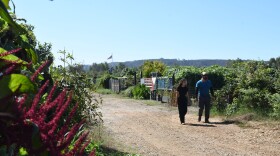Sunday night, a ring of fire burned in the sky over part of Asia and the Western United States.
To be specific, it was an annular solar eclipse. If you had the right eyeware to watch, the moon appeared smaller as it passed in front of the sun, creating a glowing ring in the sky.
Oddly enough, the eclipse moved right across the region that our Fronteras Desk covers, from California to Texas. It was a geographical and astronomical coincidence we couldn't ignore.
So three of our reporters joined crowds in the Southwest who had gathered to be wowed, although some were underwhelmed.
Cloudy skies in Oceanside left some Californians on the shore and hoping to see photos later. They went about their evenings, watching surfers and eating ice cream, unable to see much of anything. Conditions were a little better to the south in San Diego, allowing for a few hazy photos.
Viewers at the Lowell Observatory in Flagstaff got to see the spectacle. Liam Clohessy saw the moon taking out a chunk of the sun, as did Elizabeth Traslavina of Phoenix.
"It's really exciting. There are just so many people here, and it doesn't happen very often," said Jasper Pierson, who came up to Flagstaff from Phoenix.
"It's fascinating," Mike Walker of Chicago said of the 'cosmic event.'
Eclipse viewing took on almost a spiritual meaning at Petroglyph National Monument in Albuquerque.
"The eclipse was just marvelous," said Laurie Floyd of Albuquerque. "The space is sacred, it's blessed, it's very special."
"I was humbled to be a participant, to be a part of this. Humans have been seeing these for eons, but we have enough understanding to know what's going on and to share it with 200 people," Floyd said.
Ten-year-old Matthew Jordan of Albuquerque thought it was strange to see nature interfere with night and day, but happy to view his first solar eclipse.
Don't worry -- if you missed the annular eclipse last night, NASA says there'll be another one in 18 short years.


















